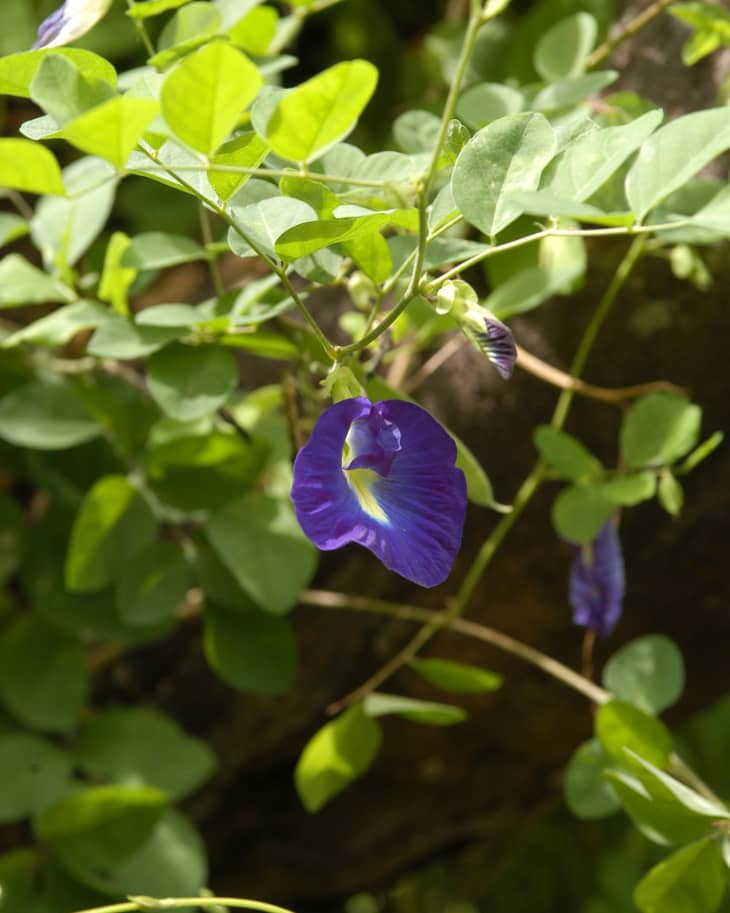The Story of Blue Curaçao: Which Is, Strangely, the Other Orange Liqueur
This flowering vine, which grows in the tropics of Asia, is known as the Butterfly Pea. Its delicate flowers are among the few sources in nature that can naturally color liquids an intense blue — and they figure into the story of one distiller’s quixotic attempt to give a much-derided spirit a well-crafted makeover.
Since this month at the 9-Bottle Bar is all about orange liqueur, we’d be remiss to not acknowledge that, in all our discussion of fine triple secs and artfully crafted Grand Marnier, we omitted any mention of blue curaçao — the, uh, free spirit of the orange liqueur family.
What Is Blue Curaçao?
Blue curaçao is essentially an orange liqueur dyed blue. The coloring doesn’t (or shouldn’t) influence the flavor, so even though you’re drinking blue, you’re tasting orange.
The origins of this offshoot product are murky. Some sources credit Bols, the Dutch spirits brand, with creating blue curaçao in the 1920s; others cite Senior Curaçao of Curaçao, a longtime orange liqueur distiller located on the island of Curaçao, as having been the first to “blue” a curaçao. Both outfits continue to produce blue curaçao today.
Is Blue Curaçao a Total Gimmick?
The product’s reputation, understandably, has been that of a gimmick — a staple of many a thatch-roofed beachside bar, but not really considered a serious cocktail ingredient outside of vacationland. One may recall that at the start of season 6 of “Mad Men,” a resort wear-clad Don Draper is served one of the quintessential cocktails of the blue curaçao canon, the Blue Hawaiian. When cocktail culture in America strayed toward the cloyingly sweet and kitschy, around the 1970s and ’80s, blue curaçao was along for the ride.
According to Brenton Engel, who operates Letherbee Distillers, a small, Chicago-based distillery best known for its gins, many of the mass-market blue curaçaos available today are made with concentrated orange flavoring in lieu of actual orange peels, and some kind of artificial food coloring to achieve the telltale electric-blue appearance. “I couldn’t think of a more bastardized liqueur out there,” he told me recently.
A Fresh Attempt for Blue Curaçao
Letherbee has taken on challenging projects, such as a crafting a rendition of the polarizing Swedish bitter liqueur bësk, and Engel thought it’d be fun for the distillery to make a more “genuine,” natural version of blue curaçao. Over the course of the past year, he and his team researched and developed a recipe for blue curaçao, only to conclude that getting the spirit to remain a radiant blue was too difficult to achieve.
Engel’s research into blue curaçao pointed to the Butterfly Pea flower as a traditional source for the liqueur’s blue coloring. Through a seller on Etsy, he managed to purchase dried Butterfly Pea flowers, which are most commonly found in Southeast Asia, where you might encounter their being used to give drinking water a pleasing, decorative blue tint.
Once Letherbee had developed a satisfactory orange curaçao recipe, through a distillation of neutral spirits with bitter and sweet orange peels (a process similar to making gin), the next step was to blanch the flowers in a small, nearly boiling portion of the liqueur, extracting the flowers’ vivid blue color. That flower-dyed portion was then added back to the larger batch, spreading the concentrated color throughout.
“The thing about using those blue flowers is it’s very difficult to stabilize that nice blue color you get from them for long periods of time,” Engel explained, “which is essentially why we put a halt to making it ourselves.” He added that, “It looks great when you first do it, but after about a month and a half…the UV rays get at [the coloring] and break it down, and it kind of just fades to a dull grayish blue.” Given the brief shelf life of the product, it wasn’t viable for sale beyond, say, a tiki bar where it would be consumed at a rapid pace.
For now we’ll have to wait for the ultimate artisanal blue curaçao to come along (if anyone is in fact doing that). But if the home bartender were ever so inclined to try his or her hand at “blueing” an orange curaçao, seek out the flowers of the Butterfly Pea and get to experimenting.
